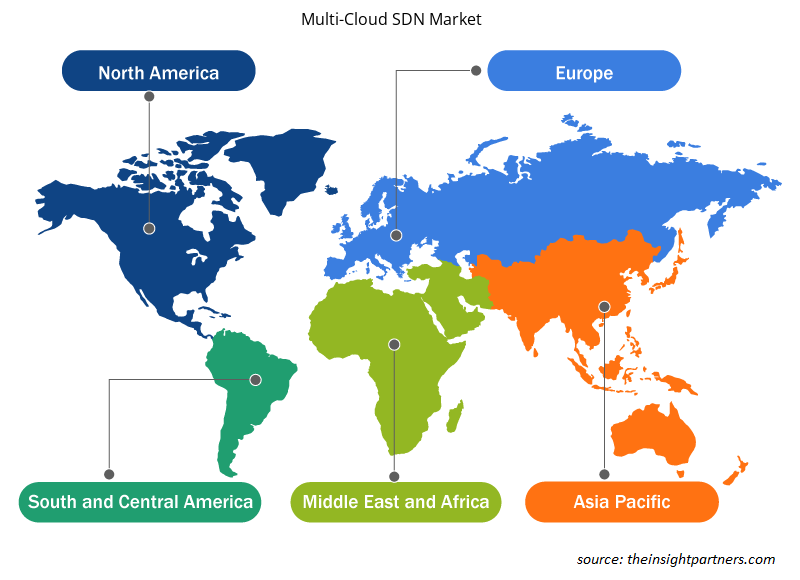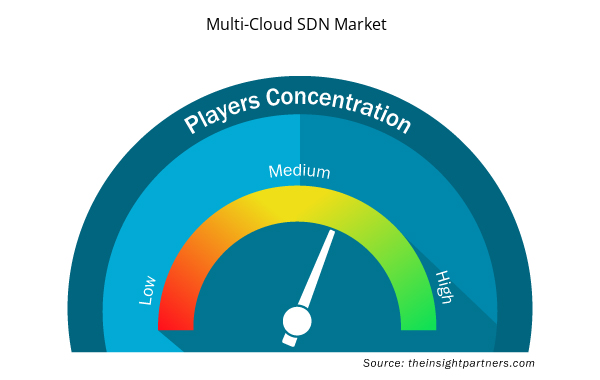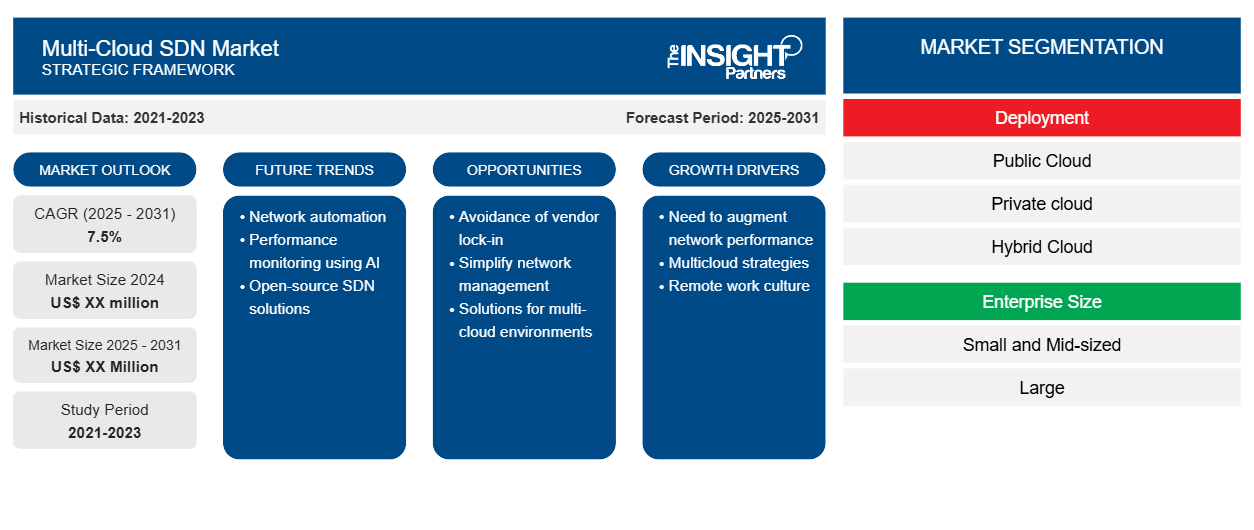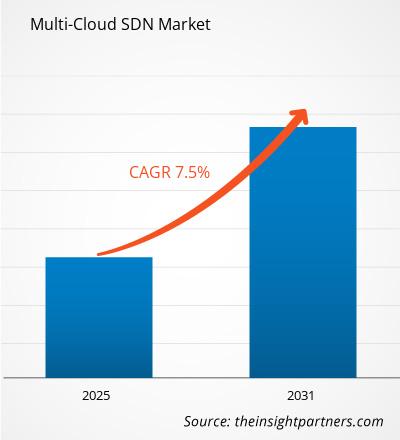Se espera que el mercado SDN multicloud registre una CAGR del 7,5 % entre 2024 y 2031, y que el tamaño del mercado se expanda de XX millones de dólares estadounidenses en 2024 a XX millones de dólares estadounidenses en 2031.
El informe presenta una descripción general analítica en profundidad del mercado de SDN multicloud segmentado por modelo de implementación, tamaño de la empresa, industrias de usuarios finales y por región. En este estudio sistemático, las partes interesadas obtendrán una vista panorámica del aumento dinámico del mercado en las principales regiones/países.
Todas las evaluaciones del informe están en dólares estadounidenses, lo que proporciona una comprensión clara de la dinámica del mercado, las tendencias de crecimiento y los paisajes competitivos para varios segmentos. Subraya cómo el cambio estratégico impulsado por la creciente adopción de SDN en entornos multicloud está cambiando las eficiencias operativas, agregando escalabilidad e innovando a escala. De
hecho, la información completa sobre el avance tecnológico, los problemas regulatorios y las tendencias emergentes ayuda a las partes interesadas a comprender cómo encontrar la oportunidad adecuada y tomar decisiones acertadas en el mercado de SDN multicloud que cambia rápidamente. El informe concluye con los elementos esenciales de la planificación estratégica y la adaptabilidad necesarias a la luz de las complejidades emergentes de la integración y la gestión de la nube que permiten a las organizaciones aprovechar de manera efectiva el poder de SDN para optimizar su respectiva estrategia multicloud.
Propósito del Informe
El informe Multi-Cloud SDN Market de The Insight Partners tiene como objetivo describir el panorama actual y el crecimiento futuro, los principales factores impulsores, los desafíos y las oportunidades. Esto proporcionará información a diversas partes interesadas del negocio, como:
- Proveedores/fabricantes de tecnología: Para comprender la dinámica cambiante del mercado y conocer las oportunidades potenciales de crecimiento, lo que les permitirá tomar decisiones estratégicas informadas.
- Inversionistas: Realizar un análisis exhaustivo de tendencias sobre la tasa de crecimiento del mercado, las proyecciones financieras del mercado y las oportunidades que existen en toda la cadena de valor.
- Órganos reguladores: Regular las políticas y vigilar las actividades del mercado con el objetivo de minimizar los abusos, preservar la confianza de los inversores y defender la integridad y estabilidad del mercado.
Segmentación del mercado de SDN multicloud
Despliegue
- Nube pública
- Nube privada
- Nube híbrida
Tamaño de la empresa
- Pequeñas y medianas empresas
- Grande
Usuario final
- BFSI
- Informática y telecomunicaciones
- Fabricación
- Transporte y Logística
- Defensa y Gobierno
- Cuidado de la salud
- Minorista
- Energía y servicios públicos
Geografía
- América del norte
- Europa
- Asia-Pacífico
- América del Sur y Central
- Oriente Medio y África
Personalice este informe según sus necesidades
Obtendrá personalización en cualquier informe, sin cargo, incluidas partes de este informe o análisis a nivel de país, paquete de datos de Excel, así como también grandes ofertas y descuentos para empresas emergentes y universidades.
- Obtenga las principales tendencias clave del mercado de este informe.Esta muestra GRATUITA incluirá análisis de datos, desde tendencias del mercado hasta estimaciones y pronósticos.
Factores impulsores del crecimiento del mercado de SDN multicloud
- Necesidad de aumentar el rendimiento de la red: el aumento de la necesidad de aumentar el rendimiento de la red y al mismo tiempo mejorar la eficiencia en todos los ecosistemas de nube crea oportunidades atractivas para el mercado de redes definidas por software de múltiples nubes.
- Estrategias multicloud: las empresas adoptan estrategias multicloud para ganar flexibilidad, mitigar el riesgo de dependencia de un proveedor y garantizar una demanda óptima de soluciones SDN para brindar una conectividad perfecta en una amplia variedad de plataformas en la nube.
- Cultura de trabajo remoto: el aumento de la cultura del trabajo desde casa y las iniciativas de transformación digital alientan a las empresas a realizar inversiones en soluciones de red rentables y escalables que sean más seguras.
- Aumento de las regulaciones de seguridad: el aumento de las regulaciones de seguridad está presionando a las empresas para que adopten tecnologías SDN que ayuden a lograr un mejor control y visibilidad sobre la infraestructura de red. Tendencias: la automatización y orquestación de la red, una mejor gestión de los entornos multicloud son las tendencias actuales. La IA y el ML también son muy importantes, ya que estas herramientas hacen que la red se optimice mucho mejor y la supervisión del rendimiento sea excelente. Mientras tanto, la informática de borde hoy en día en esta era moderna está cambiando el escenario SDN con un mayor énfasis en el cálculo y procesamiento de datos en lugares cercanos a la fuente de datos donde se mejora la latencia de la red. La mayoría de las organizaciones están buscando cómo procesar datos cerca del punto de origen, y esto se debe a la razón por la que las organizaciones de hoy dependen de la latencia de sus redes para mejorar la prestación del servicio. Las redes se están convirtiendo en soluciones SDN basadas en código abierto, por lo que una mayor flexibilidad para las organizaciones en términos de costo de red administraría sus redes de organización. El aumento de la interoperabilidad entre una variedad de proveedores de la nube conduce a una mayor colaboración entre estas organizaciones para mejorar la prestación de servicios. Factores impulsores del mercado de células solares ultradelgadas: Uno de los principales factores que contribuyen al crecimiento del mercado de células solares ultradelgadas es la creciente demanda de soluciones de energía solar más eficientes y livianas. Debido a la mejora en la tecnología de los sistemas solares, las células solares ultradelgadas se pueden diseñar para tener un material fotovoltaico más eficiente y flexible, lo que las hace adecuadas para la electrónica, los paneles solares, las aplicaciones espaciales, la electrónica portátil, la fotovoltaica integrada en los edificios y todo lo demás. Todo esto se ha visto fomentado por la tendencia actual de cambio a fuentes de energía renovables y la agenda verde mundial. Los gobiernos toman iniciativas para alentar el uso de la energía solar proporcionando incentivos y regulaciones. Esto aumenta el interés en invertir en tecnologías solares ultradelgadas debido a su inmunidad a las condiciones climáticas cambiantes. Con la continua disminución de los precios de los materiales y el proceso de fabricación de las células solares para los paneles, las aplicaciones se volverán más económicas para los consumidores.
Tendencias futuras del mercado de SDN multicloud
- Automatización de red: Las megatendencias en SDN multicloud se centran en un mayor énfasis en la automatización y orquestación de la red a través de las cuales se pueden gestionar mejor las redes de múltiples proveedores diferentes.
- Monitoreo del rendimiento mediante IA: la inteligencia artificial (IA) y el aprendizaje automático están mejorando la optimización de la red y el monitoreo del rendimiento. Como nota al margen, la computación de borde en el contexto contemporáneo también está afectando la estrategia para SDN, y las empresas hoy en día están tratando de procesar los datos lo más cerca de la fuente, ya que los datos que se procesan cerca de la fuente brindan un mejor resultado en términos de latencia mejorada.
- Soluciones SDN de código abierto: las empresas se están centrando en la independencia de los proveedores de múltiples servicios en la nube, lo que genera una mayor colaboración para mejorar la calidad de la prestación de servicios. Existe una tendencia creciente a utilizar soluciones SDN de código abierto, ya que esto brinda más flexibilidad y rentabilidad a las empresas que necesitan dicha infraestructura.
Oportunidades de mercado de SDN multicloud
- Evitar la dependencia de un proveedor: con las soluciones SDN multicloud, las empresas tendrán una mayor flexibilidad y escalabilidad de la red, que conectan sin problemas diversos entornos de nube. Además, mejora considerablemente la eficiencia operativa, mientras que evitar la dependencia de un proveedor se convierte en un problema importante para muchas organizaciones.
- Simplificar la gestión de la red: los proveedores de servicios podrán aprovechar la creciente demanda de servicios SDN gestionados ofreciendo soluciones que podrían simplificar la gestión de la red y mejorar la seguridad en un conjunto de múltiples nubes. La integración de la IA y el aprendizaje automático con las tecnologías SDN ha generado nuevas oportunidades de negocio y un mejor rendimiento de la red. Además, la automatización de las tareas administrativas podría dar como resultado una reducción del 30 % en los costes operativos, lo que impulsaría aún más el crecimiento de la cuota de mercado de SDN multicloud.
- Soluciones para entornos multicloud: los fabricantes de equipos de red pueden ofrecer nuevas soluciones de hardware y software para entornos multicloud, al tiempo que incorporan funciones que abordan específicamente la transición empresarial a infraestructuras basadas en la nube. La creciente inversión en soluciones de seguridad por parte de las empresas para prepararse ante cualquier situación cibernética puede afectar la participación de mercado y el crecimiento del mercado de SDN multicloud.
Perspectivas regionales del mercado de SDN multicloud
Los analistas de Insight Partners explicaron en detalle las tendencias y los factores regionales que influyen en el mercado de SDN multicloud durante el período de pronóstico. Esta sección también analiza los segmentos y la geografía del mercado de SDN multicloud en América del Norte, Europa, Asia Pacífico, Oriente Medio y África, y América del Sur y Central.

- Obtenga datos regionales específicos para el mercado de SDN multicloud
Alcance del informe de mercado de SDN multicloud
| Atributo del informe | Detalles |
|---|---|
| Tamaño del mercado en 2024 | XX millones de dólares estadounidenses |
| Tamaño del mercado en 2031 | US$ XX millones |
| CAGR global (2025 - 2031) | 7,5% |
| Datos históricos | 2021-2023 |
| Período de pronóstico | 2025-2031 |
| Segmentos cubiertos | Por implementación
|
| Regiones y países cubiertos | América del norte
|
| Líderes del mercado y perfiles de empresas clave |
|
Densidad de actores del mercado de SDN multicloud: comprensión de su impacto en la dinámica empresarial
El mercado de SDN multicloud está creciendo rápidamente, impulsado por la creciente demanda de los usuarios finales debido a factores como la evolución de las preferencias de los consumidores, los avances tecnológicos y una mayor conciencia de los beneficios del producto. A medida que aumenta la demanda, las empresas amplían sus ofertas, innovan para satisfacer las necesidades de los consumidores y aprovechan las tendencias emergentes, lo que impulsa aún más el crecimiento del mercado.
La densidad de actores del mercado se refiere a la distribución de las empresas o firmas que operan dentro de un mercado o industria en particular. Indica cuántos competidores (actores del mercado) están presentes en un espacio de mercado determinado en relación con su tamaño o valor total de mercado.
Las principales empresas que operan en el mercado SDN multicloud son:
- Servicios web de Amazon Inc.
- VMware, Inc.
- Empresa Hewlett Packard Inc.
- Compañía Inc.
- Corporación Oracle Inc.
Descargo de responsabilidad : Las empresas enumeradas anteriormente no están clasificadas en ningún orden particular.

- Obtenga una descripción general de los principales actores clave del mercado de SDN multinube
Puntos de venta clave
- Cobertura integral: el informe cubre de manera integral el análisis de productos, servicios, tipos y usuarios finales del mercado SDN multinube, proporcionando un panorama holístico.
- Análisis de expertos: el informe se compila sobre la base de un profundo conocimiento de expertos y analistas de la industria.
- Información actualizada: El informe asegura relevancia comercial debido a su cobertura de información reciente y tendencias de datos.
- Opciones de personalización: este informe se puede personalizar para satisfacer los requisitos específicos del cliente y adaptarse adecuadamente a las estrategias comerciales.
Por lo tanto, el informe de investigación sobre el mercado de SDN multinube puede ayudar a abrir camino para descifrar y comprender el escenario de la industria y las perspectivas de crecimiento. Si bien puede haber algunas preocupaciones válidas, los beneficios generales de este informe tienden a superar las desventajas.
- Análisis histórico (2 años), año base, pronóstico (7 años) con CAGR
- Análisis PEST y FODA
- Tamaño del mercado Valor/volumen: global, regional, nacional
- Industria y panorama competitivo
- Conjunto de datos de Excel


- Wind Turbine Composites Market
- Surgical Gowns Market
- Mobile Phone Insurance Market
- Adaptive Traffic Control System Market
- Organoids Market
- Malaria Treatment Market
- Data Center Cooling Market
- Pharmacovigilance and Drug Safety Software Market
- Flexible Garden Hoses Market
- Small Internal Combustion Engine Market

Report Coverage
Revenue forecast, Company Analysis, Industry landscape, Growth factors, and Trends

Segment Covered
This text is related
to segments covered.

Regional Scope
North America, Europe, Asia Pacific, Middle East & Africa, South & Central America

Country Scope
This text is related
to country scope.
Preguntas frecuentes
The report can be delivered in PDF/PPT format; we can also share excel dataset based on the request.
Some of the customization options available based on request are additional 3-5 company profiles and country-specific analysis of 3-5 countries of your choice. Customizations are to be requested/discussed before making final order confirmation, as our team would review the same and check the feasibility.
Key players in this market are - Amazon Web Services Inc., VMware, Inc., Hewlett Packard Enterprise Inc., Dell Inc., Oracle Corporation Inc., IBM Corp., Microsoft, Cisco Systems, Inc., Huawei Inc., Fujitsu
The market is expected to register a CAGR of 7.5% during 2023-2031
The driving factors for the Multi-Cloud SDN market include increased flexibility, scalability, and optimization of costs for cloud services. Organizations are moving toward multi-cloud strategies to avoid vendor lock-in and hence assure better performance, driving up the demand for the deployment of SDN solutions.
Future trends focus on automation and orchestration to simplify multi-cloud management. Enhanced security features will become critical as organizations adopt multi-cloud architectures. Additionally, the integration of AI for network optimization and monitoring will significantly enhance operational efficiency and responsiveness.
Trends and growth analysis reports related to Technology, Media and Telecommunications : READ MORE..
1.Amazon Web Services Inc.
2.VMware, Inc.
3.Hewlett Packard Enterprise Inc.
4.Dell Inc.
5.Oracle Corporation Inc.
6.IBM Corp.
7.Microsoft
8.Cisco Systems, Inc.
9.Huawei Inc.
10.Fujitsu
The Insight Partners performs research in 4 major stages: Data Collection & Secondary Research, Primary Research, Data Analysis and Data Triangulation & Final Review.
- Data Collection and Secondary Research:
As a market research and consulting firm operating from a decade, we have published and advised several client across the globe. First step for any study will start with an assessment of currently available data and insights from existing reports. Further, historical and current market information is collected from Investor Presentations, Annual Reports, SEC Filings, etc., and other information related to company’s performance and market positioning are gathered from Paid Databases (Factiva, Hoovers, and Reuters) and various other publications available in public domain.
Several associations trade associates, technical forums, institutes, societies and organization are accessed to gain technical as well as market related insights through their publications such as research papers, blogs and press releases related to the studies are referred to get cues about the market. Further, white papers, journals, magazines, and other news articles published in last 3 years are scrutinized and analyzed to understand the current market trends.
- Primary Research:
The primarily interview analysis comprise of data obtained from industry participants interview and answers to survey questions gathered by in-house primary team.
For primary research, interviews are conducted with industry experts/CEOs/Marketing Managers/VPs/Subject Matter Experts from both demand and supply side to get a 360-degree view of the market. The primary team conducts several interviews based on the complexity of the markets to understand the various market trends and dynamics which makes research more credible and precise.
A typical research interview fulfils the following functions:
- Provides first-hand information on the market size, market trends, growth trends, competitive landscape, and outlook
- Validates and strengthens in-house secondary research findings
- Develops the analysis team’s expertise and market understanding
Primary research involves email interactions and telephone interviews for each market, category, segment, and sub-segment across geographies. The participants who typically take part in such a process include, but are not limited to:
- Industry participants: VPs, business development managers, market intelligence managers and national sales managers
- Outside experts: Valuation experts, research analysts and key opinion leaders specializing in the electronics and semiconductor industry.
Below is the breakup of our primary respondents by company, designation, and region:

Once we receive the confirmation from primary research sources or primary respondents, we finalize the base year market estimation and forecast the data as per the macroeconomic and microeconomic factors assessed during data collection.
- Data Analysis:
Once data is validated through both secondary as well as primary respondents, we finalize the market estimations by hypothesis formulation and factor analysis at regional and country level.
- Macro-Economic Factor Analysis:
We analyse macroeconomic indicators such the gross domestic product (GDP), increase in the demand for goods and services across industries, technological advancement, regional economic growth, governmental policies, the influence of COVID-19, PEST analysis, and other aspects. This analysis aids in setting benchmarks for various nations/regions and approximating market splits. Additionally, the general trend of the aforementioned components aid in determining the market's development possibilities.
- Country Level Data:
Various factors that are especially aligned to the country are taken into account to determine the market size for a certain area and country, including the presence of vendors, such as headquarters and offices, the country's GDP, demand patterns, and industry growth. To comprehend the market dynamics for the nation, a number of growth variables, inhibitors, application areas, and current market trends are researched. The aforementioned elements aid in determining the country's overall market's growth potential.
- Company Profile:
The “Table of Contents” is formulated by listing and analyzing more than 25 - 30 companies operating in the market ecosystem across geographies. However, we profile only 10 companies as a standard practice in our syndicate reports. These 10 companies comprise leading, emerging, and regional players. Nonetheless, our analysis is not restricted to the 10 listed companies, we also analyze other companies present in the market to develop a holistic view and understand the prevailing trends. The “Company Profiles” section in the report covers key facts, business description, products & services, financial information, SWOT analysis, and key developments. The financial information presented is extracted from the annual reports and official documents of the publicly listed companies. Upon collecting the information for the sections of respective companies, we verify them via various primary sources and then compile the data in respective company profiles. The company level information helps us in deriving the base number as well as in forecasting the market size.
- Developing Base Number:
Aggregation of sales statistics (2020-2022) and macro-economic factor, and other secondary and primary research insights are utilized to arrive at base number and related market shares for 2022. The data gaps are identified in this step and relevant market data is analyzed, collected from paid primary interviews or databases. On finalizing the base year market size, forecasts are developed on the basis of macro-economic, industry and market growth factors and company level analysis.
- Data Triangulation and Final Review:
The market findings and base year market size calculations are validated from supply as well as demand side. Demand side validations are based on macro-economic factor analysis and benchmarks for respective regions and countries. In case of supply side validations, revenues of major companies are estimated (in case not available) based on industry benchmark, approximate number of employees, product portfolio, and primary interviews revenues are gathered. Further revenue from target product/service segment is assessed to avoid overshooting of market statistics. In case of heavy deviations between supply and demand side values, all thes steps are repeated to achieve synchronization.
We follow an iterative model, wherein we share our research findings with Subject Matter Experts (SME’s) and Key Opinion Leaders (KOLs) until consensus view of the market is not formulated – this model negates any drastic deviation in the opinions of experts. Only validated and universally acceptable research findings are quoted in our reports.
We have important check points that we use to validate our research findings – which we call – data triangulation, where we validate the information, we generate from secondary sources with primary interviews and then we re-validate with our internal data bases and Subject matter experts. This comprehensive model enables us to deliver high quality, reliable data in shortest possible time.


 Obtenga una muestra gratuita de este informe
Obtenga una muestra gratuita de este informe